
by Rick O'Connor | Oct 2, 2020
Is this what it sounds like? Fish that do not swim, but drift? Well… yes and no. They can swim, just not very well – they do better by drifting.
The word used most often for any drifting creature in the sea is plankton. Plankton literally means “drifter” or “wanderer”. Most plankton, including planktonic fish, can swim. Some can adjust their position in the water column – rising near the surface at night, sinking deeper during the day.
When you think about it, it is a cool way to make a living out there. With miles and miles of open blue water, the swimming fish must keep swimming. To do this requires a lot of energy, open water fish must consume a lot of high energy food. Drifters just drift. Hang with the currents, enjoying the moment, eating what they can. Sounds pretty good huh?
As you can imagine, there are not many fish who live this lifestyle. Many do after they hatch in their larval stage – but as adults, most live on the bottom, others in the open blue. Let’s meet a couple of the drifters.
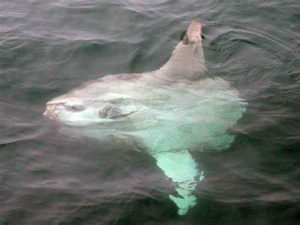
The slow moving ocean sunfish.
Photo: NOAA
Sunfish
Now here is one weird looking fish. Large bulbous head, long angular dorsal and ventral fins, and no tail – it’s a swimming/drifting head. These large open water drifters can reach seven feet long, seven feet high, and weigh over a ton. They can hold their position, undulating their dorsal and ventral fins, and move slowly through the water. Often, they will turn on their sides and just hang there. Looking like a floating board or something, small creatures are attracted to them, some of which they eat. Their diet is primarily jellyfish, though they have been known to take small fish, crustaceans, and even algae.
They are related to puffer fish, and actually resemble them early in life, but the resemblance fades quickly as this becomes more head than anything else.
Though rarely seen near shore, they have been, and one was actually spotted inside Pensacola Bay. They occasionally wash ashore dead. One did on Dauphin Island. The staff at the Sea Lab made a mold of the dead creature which is now hanging in the public Estuarium there. Many know this fish by its scientific name – Mola mola – or simply “the mola”. It is a pretty cool fish.
https://www.montereybayaquarium.org/animals/animals-a-to-z/ocean-sunfish/
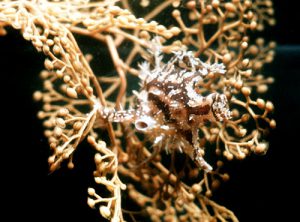
This sargassum fish is well camouflaged within this mat of sargassum weed.
Photo: Florida Museum of Natural History
Sargassum Fish
Sargassum fish are members of a family known as “frogfish” – so you can guess what they must look like – and can guess they are not real good swimmers. Almost completely round, they are blobs in the sea. There are three species in the Gulf, two if which are bottom fish. However, the Sargassum fish is a drifter – drifting with the common seaweed known by its scientific name Sargassum. Sargassum is brown algae that produces air bladders called pneumatocyst. These bladders allow the weed to drift in large mats at the surface where they get sunlight. Some sargassum mats are huge is size and are an ecosystem amongst themselves. Hundreds of miniature fish and invertebrates call this place home – a place to hide in the open sea. It is the home of baby sea turtles, if they can make the trek from the beach alive.
One member of this community is the Sargassum fish (Histrio histrio). It has the typical frogfish shape and look but the coloration matches the Sargassum weed perfectly. Like other frogfish, the first dorsal spine is modified into a “fishing rod” complete with a “lure”. When prey (small creatures in the Sargassum weed) are in view, the Sargassum fish will extend the illicium (as it is called) and actually move it back and forth to make it look like live bait – they are fishing.
Most members of the Sargassum community flee the weed when the currents bring it to close to the beach. However, they hang on longer than you might think. If you are at the beach when the Sargassum is drifting just off the shore – wade out with a small kids dip net and snag a patch. Place in a bucket and see who comes out. You MIGHT get lucky and catch one of these ocean drifters.
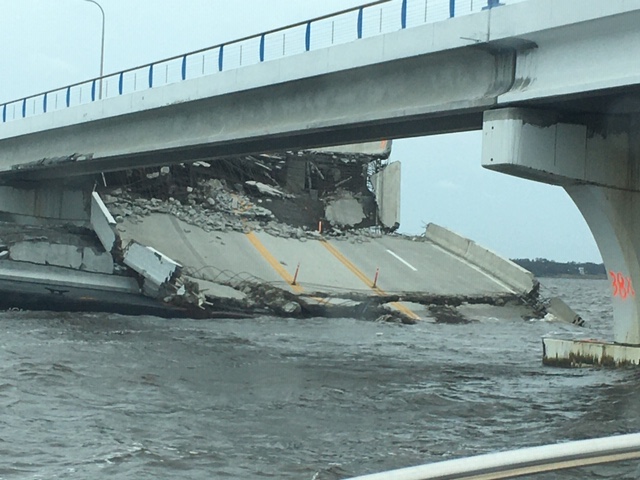
by Rick O'Connor | Sep 25, 2020
It began easy enough – a tropical storm making landfall between Louisiana and Mississippi. Northwest Florida could expect some rain and rising water. Okay…
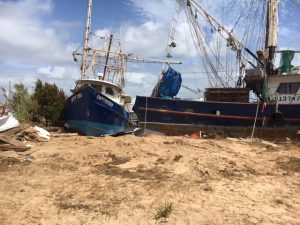
Shrimp boats from Allen Williams Seafood in Pensacola on shore. Most of the shrimp boats were.
Photo: Rick O’Connor
A few hours later the new landfall was predicted to be the Mississippi-Alabama coastline. This changes things a bit. We are expecting slightly higher winds, higher water, this will probably be a rain event. Some school districts closed; others were waiting to see. We already had our boat ready for Laura, which went further west than predicted, so we were ready. Tropical storm winds were doable as long as we did not get a direct hit. It was heading west of us. We were along the outside edge of the “cone of uncertainty”. I think we are good. Many others felt the same way.
Later, it was a sunny day and I was in a zoom meeting when my wife, a teacher, poked her head in and said they were closing schools through Wednesday. What? What is going on? Closing school for two days for a tropical storms that is going in west of Mobile AL? We should check out the weather channel. We did… it was now heading for the Alabama-Florida line. It was a strong tropical storm possible Category 1 hurricane. Maximum winds would be near 90 mph.
Pause…
We made a few more preparations. We actually got some boards up when the rain began but could not get them all up (we have 23 windows in our house). The sun set, the rain came harder, the wind picked up, and the weather service changed their forecast again – winds to increase to 110 mph – probably make landfall as a Category II storm. They issued a hurricane warning for counties further east including Walton County. The high winds and rain whipped Pensacola all through the night and much of the next day. We were in the eye wall of a Category II storm. No one was prepared for this.
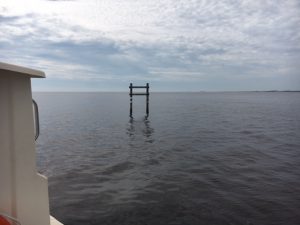
Several channel and day markers for navigation are damaged or missing. Mariners should be cautious.
Photo: Rick O’Connor
In the aftermath there was the typical hurricane damage. Downed trees, some on houses, boats on the beach, flooded homes, and – like other storms – some properties that were barely touched, or untouched all together. Power and water were out, and many roads were impassible. Oh, what a night…
There was something different this time. A company out of Virginia was building a new bridge over Pensacola Bay. They had completed the south bound section, tore down the old bridge, and were working on the north bound section while the south bound was being used. They had numerous barges anchored all over the bay full of work equipment, cranes, etc. For what ever reason, they did not move these into one of the bayous. The lines broke and many barges drifted. Some landed along the shorelines, some hit the bridge – the southbound section of the bridge – and it is now closed. This is part of Highway 98 from Pensacola to Gulf Breeze and used by hundreds of thousands of people each day. It is closed and traffic access for many in the community has changed. This is going to be tough.
But this newsletter is about natural resources… what about that?
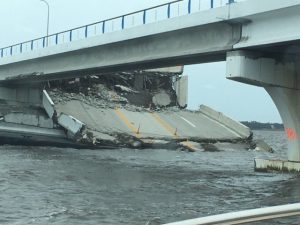
A section of the new 3 Mile Bridge over Pensacola Bay hangs down after being hit by one of the many barges adrift that night.
Photo: Rick O’Connor
As you might guess the water within the bay is a mess. There were hundreds of vessels that sank. You can see the fuel and oil slicks leaking from them on the surface of the water. You can also see pelicans and gulls swimming on and in it. There have been no reports of fish kills yet, but – to my knowledge – there has been no water sampling other than for bacteria. We know there were several sanitary sewer overflows due to the high rainfall amounts – I recorded 20.4” over the two-day period at my house. The water is a deep brown color and you can smell it in some locations. Health advisories are currently issued for all bodies of water that the Department of Health sample. No one should be in the water.
Along those same notes, no one should be boating at this time either. During our boat assessments of the area waters we saw numerous objects – such as docks, day markers, road work markers, and more – drifting all over the bay. Some floating, some slightly submerged. We managed to bump a submerged tree in one of the bayous and also managed to get a large sheet of plastic wrapped around our props. Boating is discouraged at this time. We know some of the fishing charters (smaller vessels) are going to try and fish this weekend. We understand this – they need the revenue – but we caution them to be on the look out for this debris.
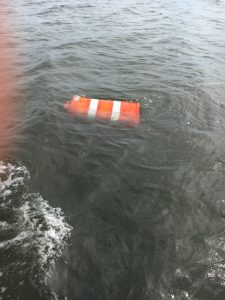
This highway work can was piece of thousands of pieces of debris floating in the bay. Mariners be cautious.
Photo: Rick O’Connor
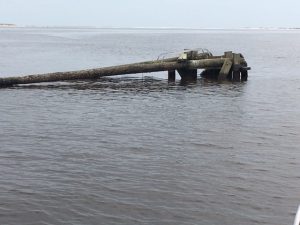
This drifting day marker ran aground on a shoal in the ICWW near Ft. Pickens. At the time of this photo, it was unmarked and had no light on it. Mariners be cautious.
Photo: Rick O’Connor
I have not been on the barrier islands, but photos show severe erosion on portions and there are three new inlets on the east end of Perdido Key, one of those we could see from our boat. We have no idea what impacts this storm had on the wildlife but it fair to say that things have changed. We alerted residents to be aware of snakes while doing clean up – we will alert them again. I remember after Ivan the increase in the hawk activity due to downed and thinned trees – squirrels were now easier targets. This has happened again. There is one really large red-tailed hawk hanging around our house and doing quite well.
At the time of this writing, I have not contacted the local wildlife sanctuary, but I am guessing injured and orphaned animals will increase. The wildlife sanctuary itself took on water, but almost all of the animals survived, and they are back at work.
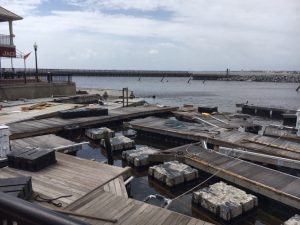
This marina, and many others, will be out of service for quite some time.
Photo: Rick O’Connor
So, from a natural resource stance – water is poor, do not swim – fish are not dying, but would hold off fishing inland – keep an eye out for wandering wildlife, such as snakes, that have been displaced. We are expecting sick and injured birds due to oil slick and other debris issues.
There is one last lesson from Sally… be prepared. We have become very comfortable with the forecast. Northwest Florida was outside the “cone” for a tropical storm making landfall near Mississippi – and then. As we all know these storms can change direction and intensify (remember Michael’s turn east) at a moments notice. Any storm with name in the Gulf should be taken seriously, whether tropical storm or not.
Stay safe.
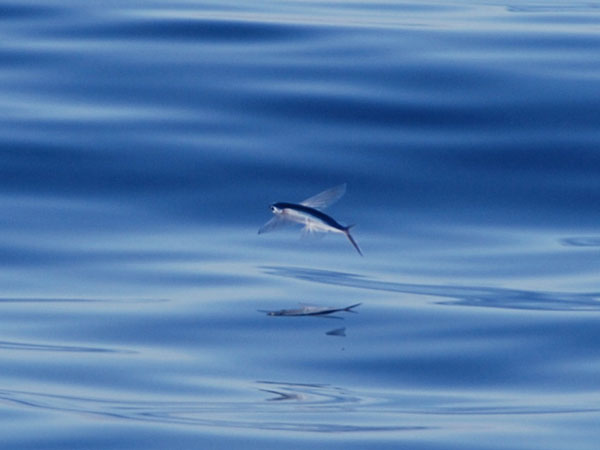
by Rick O'Connor | Sep 11, 2020
There is a lot of blue out there… a whole lot of blue. Miles of open water in the Gulf with nowhere to hide… except amongst yourselves. Their blue colored bodies, aerodynamically shaped like bullets with stiff angular fins, can zip along in this vast blue openness in large schools. Their myoglobin rich red muscle increases their swimming endurance – they can travel thousands of miles without tiring. Some species are what we call “ram-jetters”, fish that basically do not stop swimming – roaming the “big blue” looking for food and avoid being eaten, following the warm currents in search of their breeding grounds.
The open water is a place for specialists. Most of these fish have small, or no scales, to reduce frictional drag. They have a well-developed lateral line system so when a member of the school turns, the others sense it and turn in unison – just as the four planes in the US Navy Blue Angels delta do – perfect motion.
Many are built for speed. Sleek bodies with sharp angular fins and massive amounts of muscle / body mass, some species can reach speeds close to 70 mph – some can “fly”. There are fewer species who can live here, as opposed to the ocean floor, but those who do are amazing – and some of the most prized commercial and recreational fishing targets in the world. Let’s meet a few of them.
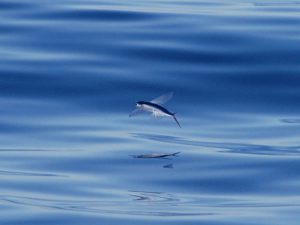
Flying fish do not actually “fly”, they are gliders using their long pectoral fins.
Photo: NOAA
Flying Fish
First, they do not actually fly – they glide. These tube-shaped speedy fish have elongated pectoral fins, reaching half the length of their bodies. The two lobes of their forked tail are not the same length – the lower lobe being longer. Using this like a rudder, they gain speed near the surface and, at some point, leap – extend the large pectoral fins, and glide above the water – sometimes up to 100 yards. As you might guess, this is to avoid the sleek speedy open water predators coming after them. You might also imagine that they, and their close cousins the half-beaks, are popular bait for the bill fishermen seeking those predators.
There are eight species of these amazing fish in the Gulf of Mexico ranging in size from 6-16 inches. Most are oceanic – never coming within 100 miles of the coast, but a few will, and can, be seen even near the pass into Pensacola Bay.
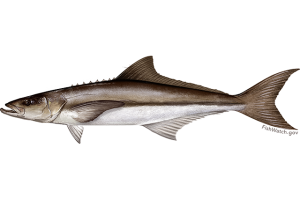
The cobia – also known as the ling, lemonfish, and sergeant fish, is a migratory species moving through our area in the spring.
Image: NOAA
Cobia
This is one of the migrating fish local anglers gear up for every year – the cobia run. When the water turns from 60° to 70°F in the spring – the cobia moves up the coastline heading from east to west. They have many different common names along the Gulf Coast. Ling, Cabio, Lemonfish, and Sergeant fish have all been used for this same animal. This is one reason biologists use scientific names – Rachycentron canadum in this case. That way we all know we are talking about the same fish. Whatever you call it, it is popular with the anglers and there is nothing like a fresh cobia sandwich – try one!
They can get quite large – 5 feet and up to 100 pounds – and resemble sharks in the water, sometimes confused with them. They seem to like drifting flotsam, where potential prey may hangout, and fishermen will toss their baits all around their schools trying to get them to take. At times, fishermen have confused sea turtles with cobia and have accidentally snagged them – only to release it, though it is a workout to do so, and they try to avoid it.
Cobia are in a family all their own. Their closest relatives are the remoras, or sharksuckers, which sometimes attach to them. They travel all over the Gulf and Atlantic Ocean.
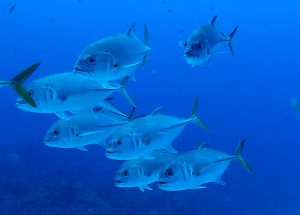
Jacks have the sleek, fast design of the typical open water marine fish.
Photo: NOAA
Jacks
This is the largest open water family of fish I the northern Gulf – with 24 species. Not all jacks are open water, many are found on reefs and in estuaries. But these are aerodynamic shaped fish, with small scales and angular fins, and built for the open water environment. They vary in size, ranging from less than one foot, to over three. This group is identified by the two extended spines just in front of their anal fin. Several species – such as the amberjacks, pompano, and almaco jacks – are prized food fish. Others – like the jack crevalle and the blue runner (hardtail) – are just fun to catch, putting up great fights.
They are schooling fish and often associated with submerged wrecks and reefs, where prey can be found. The black and white pilot fish is called this because mariners would see them swimming in front of sharks – “piloting” them through the ocean. They are open water jacks but are more tropical and accounts in our area are rare.
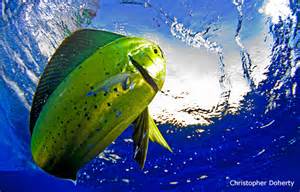
The colors of the mahi-mahi are truly amazing.
Photo: National Wildlife Federation
Mahi–Mahi
This is the Hawaiian term for a fish called the dolphin (Coryphaena hippurus). You can probably guess why they prefer to call it by its Hawaiian name. It is a popular food fish, and to have “dolphin” on the menu – or to say “hey, we’re going dolphin fishing – want to come?” would raise eyebrows – and have.
The Mexicans call it “dorado”, and that term is used locally as well. Either name – it is an amazing fish. With the bull-shaped forehead of the males – they are sometimes referred to as the “bull-dolphin”. Their colors, and color changing, is amazing to see. Some biologists believe this may be some form of communication between members, don’t know, but the brilliant greens, blues, and yellows are amazing to see. They lose these colors shortly after death, so you must see it to believe it – or find one of the popular fish t-shirts.
Like jacks, dolphin like to hang around flotsam, or large schools of baitfish, looking for prey. As with many other open water predators, they will sometimes work in a team to scare, and scatter, individuals from the safety of their school. There are only two species in this family, and both are prized for their taste.

The Striped Mullet.
Image: LSU Extension
Mullet
This is not one you would typically call an “open water” fish. But in the nearshore Gulf and estuaries, they are more open water than bottom dwellers – though they do feed off the bottom. Sleek bodied, forked tail, angular fins, they have what it takes to be a fast swimmer. Though they do not “fly” as the flying fish do, they do leap out of the water. Many visitors hanging out around the Sound will hear a fish splash and immediately ask “what kind of fish was that?” Many locals will respond without looking up – “it was a mullet” – and they are probably right.
This brings up the age-old question… why do mullet jump? This was once asked of a marine biology professor. He paused… thought… and responded saying “for the same reasons manta rays jump”. That was it… another long pause. Finally, the students “took the bait” – “Okay, why do manta rays jump?”. The professor replied, “we don’t know”. So, there you go.
Another interesting thing about this fish is its wide tolerance of salinity. Mullet have been found in freshwater rivers and springs and the hypersaline lagoons of south Texas – they truly don’t care.
Locally they are popular food fish, and support a large commercial fishery in Florida, but in other parts of the Gulf not so much. It has to do with their environment and what they are feeding on. In muddier portions of the Gulf (or our bay for that matter) they have an oily taste and locals there call the “trash fish”. Even hearing that locals here eat them “grosses” them out. Local respond by giving it a more “high end” name – the Mulle (spoken with a French accent). This is actually the Cajun term for the fish. And let’s step it up a notch by adding that many locals eat mullet row – the eggs. Yea… getting hungry right? One of the popular cable food shows came here to try mullet roe. They said on a scale of 1 to 10, they give it a -4.
All that said, it is a local icon – with seafood stores selling “In Mullet We Trust” t-shirts, and the popular “Mullet Toss” event held every year on Perdido Key. It is a COOL fish.
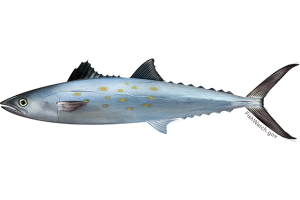
This Spanish Mackerel has the distinct finlets of the mackerel family along the dorsal and ventral side of the body.
Image: NOAA
Mackerel
When you mention mackerel around here you usually think of one of two fish – the king mackerel (sometimes just referred to as “the king”) and the Spanish mackerel. But it is actually a large family of open water fish that includes the tuna, bonito, and the wahoo (of baseball fame).
They are some of the fastest fish in the sea, and several species are ram-jetters. Sleek bodies, sharp angular fins, they can be identified by the row of small finlets on the dorsal and ventral sides of their bodies near the rear. Full of red muscle, rich in myoglobin (which can hold more oxygen than hemoglobin alone), these are powerful swimming fish and very popular in the sushi trade. A bluefin tuna can be 14 feet long, 800 pounds, and bring a commercial fisherman tens of thousands of dollars. Because of this bluefin tuna are internationally protected and managed.
Another cool thing about these guys is that some species can control blood flow, and location, to help maintain a higher body temperature – “warm blooded” – allowing them to venture into colder waters of the world’s oceans. They are one of the big migratory fish we find. Following the large ocean currents, some species use this to play out their entire life cycle. Born in the warmer portions of the ocean gyres, they grow and feed in the cooler areas, returning in the warmer currents to breed.
There are 12 species in this family ranging in size from 1 to 15 feet. They have the characteristic “dark on top – light one bottom” coloration many animals have. This called countershading. It is believed to be used as a form of camouflage in the deep blue – with the darker blue-indigo on top (to blend in with the bottom if look from above) and the lighter silver-white on the bottom (to blend in with the sunlit surface if viewed from the below). This idea was used by the US Navy during World War II. If you visit our Naval Aviation Museum, you will see they painted the planes a darker blue on top and a lighter white on bottom. In hopes that the Japanese pilots would have a hard time spotting them over the Pacific Ocean. It is also believed to help with temperature control. The darker side will absorb heat, while the lighter side releases – avoiding over-heating. Amazing fish, aren’t they?
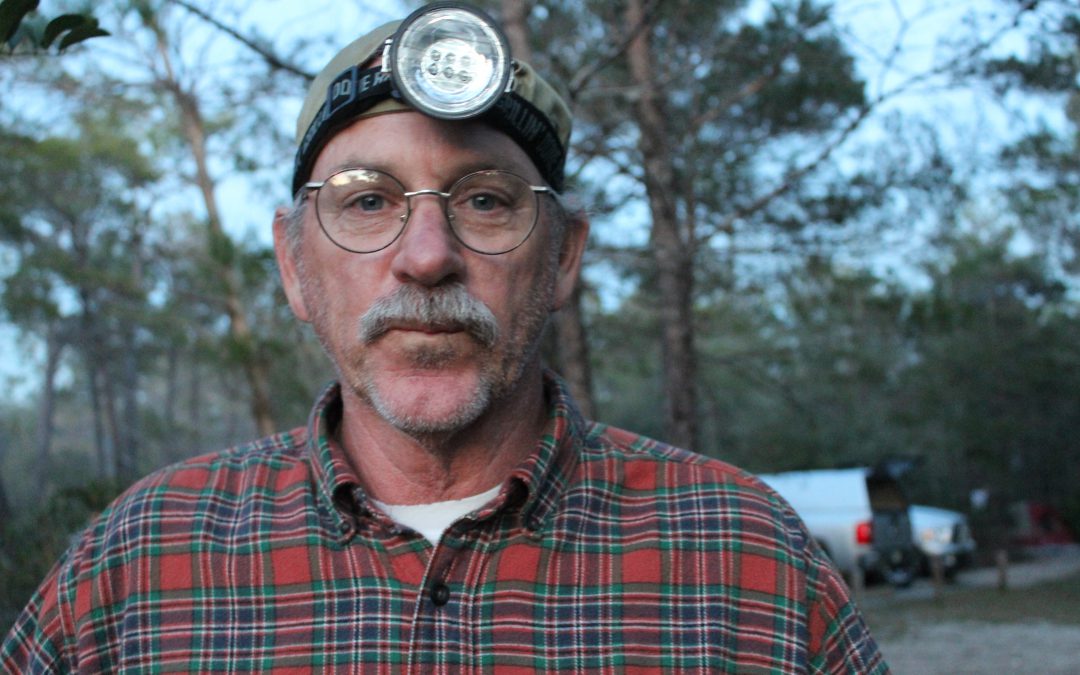
by Rick O'Connor | Sep 8, 2020
Rick joined the University of Florida IFAS extension team in 2012 after 28 years in public education. He is the Sea Grant Extension Agent in Escambia County and his program focus areas are on estuaries and science literacy. His primary projects involve training citizen scientists to monitor the bay, management invasive species, coastal wildlife education, and assisting businesses with a marine focus.
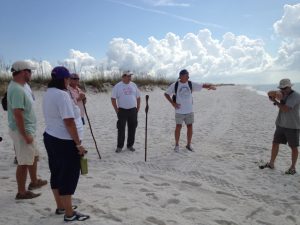
A native of Pensacola, Rick’s family had him camping at a very early age, where he developed his love of wildlife and the outdoors. While in elementary school they bought him is first mask and snorkel. He was mesmerized by the number of fish and his career path began. He received his bachelors degree from Troy University where his marine biology courses were at Dauphin Island Sea Lab. His masters in vertebrate zoology came from the University of Southern Mississippi. He found his way into the marine education pretty quickly. He began teaching marine science at a local high school but also taught summers at Dauphin Island Sea Lab for seven years and was an adjunct at Pensacola State College for 15 years. In 1995 he created the Institute of Coastal and Marine Studies program at Washington High School. This program focuses on high school students interested in a career in marine science and continues today as the Marine Science Academy.
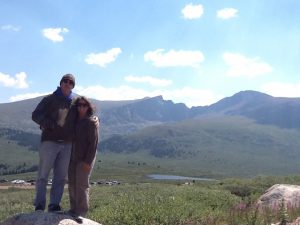
Rick has spent his life in and around the water and, as his parents did, has introduced his kids and grandkids to the outdoors at an early age. Camping, snorkeling, hiking, paddling, and exploring are frequent weekend haunts of the O’Connor clan. There is also the annual camping trip out west every July. He is a member of the national, and regional, Diamondback Terrapin Working Group and the Southeast Partners in Reptile and Amphibian Conservation as well as several working groups within Florida Sea Grant that focus on estuarine issues.
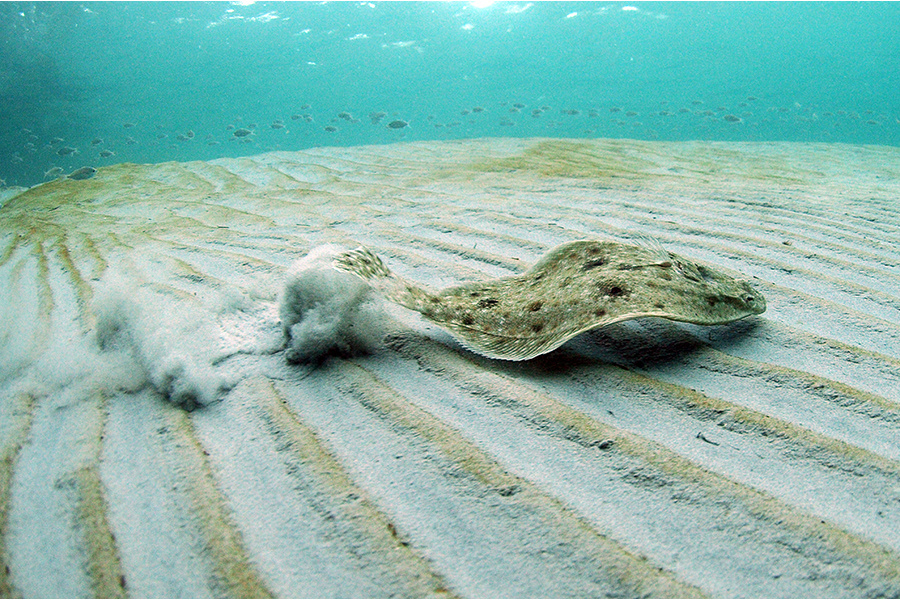
by Rick O'Connor | Sep 3, 2020
We continue our series on estuarine and marine fish and wildlife with fish who live on the bottom.
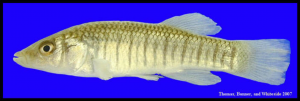
This longnose killifish has the rounded fins of a bottom dwelling fish.
The Gulf of Mexico is a huge ecosystem. With 600,000 m2 and an average depth of 6000 feet, there is a lot of “blue” out there for fish to find a home. But oddly enough, 69% of the species describe in the northern Gulf live on the bottom – what we call benthic fish.
This makes since really. In the “open blue” there are few places to hide from predators and prey. On the other hand, the seafloor has numerous places to hide – so there they are.
Most benthic fish have a general body design for living there. They are generally deep bodied, more rounded – as are their fins. They have a higher percentage of white muscle which makes them very explosive – for a few seconds. This is how they live. Blending in with the bottom, waiting for the prey to get within range and then exploding on it. This white muscle also gives these fish a distinctive taste, different from the red muscle typically found in the open water fish such as tuna.
In this environment, the sense of smell is very good. Many have taste and smell buds extended on fleshy appendages called barbels (the “whiskers” of a catfish). Many will have their mouth on the bottom side of their head for easier eating – though the predators (like the grouper) will still have it directly in front. Many will make short migrations into estuaries for breeding, but long open ocean migrations are not common. There are 342 species of benthic fish in the northern Gulf, let’s look at a few.
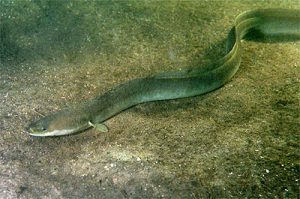
The Anguilla eel, also known as the “American” and “European” eel.
Photo: Wikipedia.
Eels
Something about these animals creeps us out. Maybe their similarity to snakes? Maybe the thought they are electric or venomous – neither of which are true. There are electric eels in the Amazon, but not in the ocean. They do behave much like snakes in that they have very sharp teeth for grabbing prey and can use them on fishermen if they need to. There are 16 species of eels in the northern Gulf. With the exception of the morays – eels live in sandy or muddy bottoms. Shrimpers frequently haul them up, and some are even known as shrimp eels. The American eel (Anguilla rostrata) has a cool life history. They spawn in the middle of the Atlantic Ocean, a place known to the sailors as the Sargasso Sea. It is in the middle of the vortex of ocean currents. The young that catch the northern currents and head to Europe – there they are known as the “European Eel”. Those that catch the southern swirl end up here in the United States are known as the “American Eel”. Their young look like thin pieces of plastic with eyes. Known as elvers they can be found within Pensacola Bay by the thousands when they arrive. The growing adults move up stream and spend part of their lives in our rivers and springs, before swimming back to the Atlantic and starting the process all over. In some areas, there is a commercial fishery for this eel.
Read more:
https://fws.gov/fisheries/freshwater-fish-of-america/american_eel.html.
https://www.fws.gov/fisheries/fishmigration/american_eel.html.
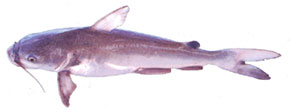
The serrated spines and large barbels of the sea catfish. Image: Louisiana Sea Grant
Catfish
This is a bottom fish that fishermen love to hate. Marine catfish (Ariopsis felis) are oily and not as popular as their freshwater cousins as food. So, when fishermen catch them, they tend to toss them on the beach to die – the idea is that there are fewer to breed – an idea that really does not work – they keep catching them. One interesting twist on this story is that the ghost crabs in the dunes drag the dead ones towards their burrows where they feed on them. The skull of the sea catfish is very hard – giving them their other common name “hardhead” catfish, or “steelhead”. When the crabs are finished the hard skull can be found and the bones on the belly (ventral) side resemble the cross. It is sold in some novelty stores as the “crucifix fish”. To add to the legend, when you shake it, it rattles. This has been described at the “soldiers rolling dice” at the crucifixion. They are actually loose bones. These “crucifix fish” are pretty neat, and pretty common.
The long “whiskers” (barbels) are for finding food buried beneath the sand or mud. It is also believed they may have a form of echolocation to detect prey. As if this were not interesting enough – the males carry the developing eggs within their mouths. Development takes about two weeks and young fish emerge from dad ready for the world.
One other thing the visitor should know – the serrated spine on the dorsal and the pectoral fins can inflict a nasty wound, even releasing a mild toxin. Most discover this when they step on a dead one tossed on the beach, or trying to get one off their hook – be careful of this.
Read more:
https://en.wikipedia.org/wiki/Hardhead_catfish.
http://gcrl.usm.edu/public/fish/hardhead.catfish.php.
https://www.floridamemory.com/items/show/269847.
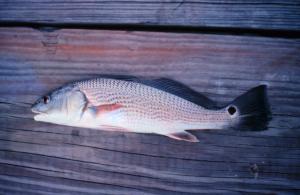
The classic look of a bottom fish. This is the redfish, or red drum.
Photo: NOAA
Drum–Croaker
This is the largest family of estuarine fish in the northern Gulf of Mexico – with 18 species described. The whiting, drum, kingfish, croakers, trout, some perch, and others all belong to this group. They are popular with fishermen and seafood consumers. The red drum (redfish) is one of the more popular targets in our area. Speckled trout (or spotted seatrout) are also a favorite. Most have the characteristic body of a benthic fish. Deep bodied, rounded fins, mouth on the belly (ventral) side. Sea trout have two large “Dracula” looking fangs for grabbing shrimp and other prey. In most, one has broken off and the angler usually finds only one fang present. Some species, such as the black drum, will have short “whiskers” on their chins – you guessed it, barbels – and they are used for finding “buried treasure” (food).
Their common name drum (or croaker) comes from the sounds they produce using their swim bladders. Swim bladders are large sacs within many fish they can fill with gas and float off the bottom. The drum-croaker group rub this with internal muscles making resonating sounds that sound like they are “croaking”. Atlantic bottlenose dolphin can hear this too – and croakers make up a big part of their diet.
Read more:
http://gcrl.usm.edu/public/fish/red.drum.php.
http://gcrl.usm.edu/public/fish/spotted.seatrout.php.
http://gcrl.usm.edu/public/fish/southern.kingfish.php
http://gcrl.usm.edu/public/fish/sand.seatrout.php
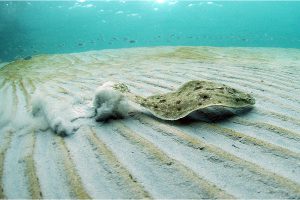
A flounder scurrying across the seafloor.
Photo: NOAA
Flounder
There are actually two types of flatfish in the Gulf – the flounder and the sole. How do you tell them apart?
Well, they are born as a typical-normal looking fish, but as they grow one eye begins to “slide” across the top of the head to the other side – both eyes are now on one side of the head – weird right?
In our part of the Gulf, if the eyes slide to the left side – we call it a flounder, to the right – a sole. There are a FEW exceptions to this rule – but many call the popular flounder the “left-eyed flounder” as opposed to the “right-eyed” one.
So why do they do this?
If your eyes were placed on each side of a torpedo pointed head, you would have what we call monocular vision. This type of vision gives you ALMOST 360° range of view… almost. So even though you can see what is behind you while facing forward, you do not have good depth perception – so you are not sure exactly how far away it is. You must either rely on other senses to help you out or get lucky. Having both eyes on one side (or in front like us) you have binocular vision. You cannot see behind you, but you can tell the distance of the object in front of you. This is common for predator fish like flounder. Many would agree that your mother has both!
With the eyes on one side of the head, they lose color on the other and then lay flat on one side. They can bury in sand and wait for prey. Most species have chromatophores in their skin. These are cells that allow them to change color, like a chameleon or octopus. So, they can change their color to blend into whatever bottom type they are on. What an incredible adaptation.
There are 17 species of flounder, and they are not easy to tell apart – so just call them flounder.
Read more:
http://gcrl.usm.edu/public/fish/flounder.php.


























